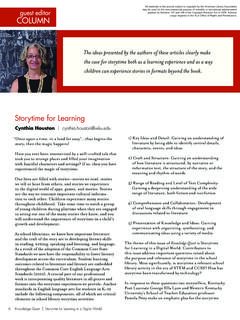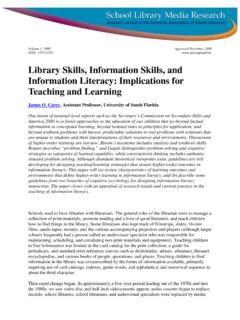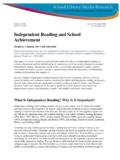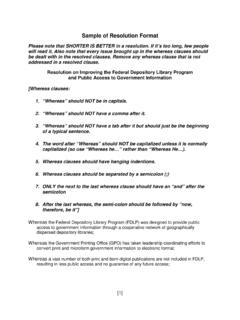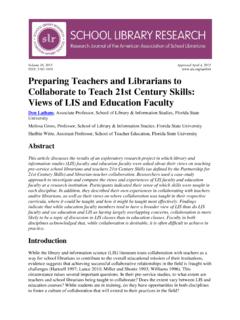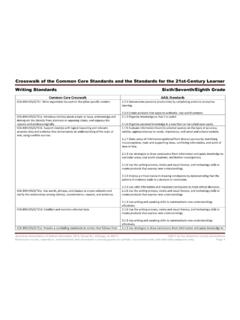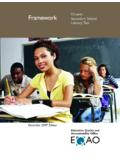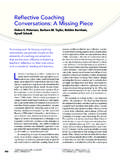Transcription of ALA/AASL Standards for Initial Preparation of School ...
1 ALA/AASL Standards for Initial Preparation of School Librarians (2010). Approved by Specialty Areas Studies Board (SASB) of the National Council for Accreditation of Teacher Education (NCATE), October 24, 2010. The ALA/AASL Standards for Initial Preparation of School Librarians apply to all master's programs that prepare candidates to develop and manage library and information services in a PreK-12 setting, regardless of degree name or professional title. School librarian is the official professional title adopted by the American Association of School Librarians (AASL) and the American Library Association.
2 Other titles include, but are not limited to, School library media specialist, teacher librarian, library information specialist, and media coordinator.. Standard 1: Teaching for learning Candidates are effective teachers who demonstrate knowledge of learners and learning and who model and promote collaborative planning, instruction in multiple literacies, and inquiry-based learning , enabling members of the learning community to become effective users and creators of ideas and information. Candidates design and implement instruction that engages students' interests and develops their ability to inquire, think critically, gain and share knowledge.
3 Elements Knowledge of learners and learning Candidates are knowledgeable of learning styles, stages of human growth and development, and cultural influences on learning . Candidates assess learner needs and design instruction that reflects educational best practice. Candidates support the learning of all students and other members of the learning community, including those with diverse learning styles, physical and intellectual abilities and needs. Candidates base twenty-first century skills instruction on student interests and learning needs and link it to the assessment of student achievement.
4 Effective and knowledgeable teacher Candidates implement the principles of effective teaching and learning that contribute to an active, inquiry-based approach to learning . Candidates make use of a variety of instructional strategies and assessment tools to design and develop digital-age learning experiences and assessments in partnership with classroom teachers and other educators. Candidates can document and communicate the impact of collaborative instruction on student achievement. Instructional partner Candidates model, share, and promote effective principles of teaching and learning as collaborative partners with other educators.
5 Candidates acknowledge the importance of participating in curriculum development, of engaging in School 2010 ALA/AASL Standards for Initial Preparation of School Librarians Page 1 of 20. improvement processes, and of offering professional development to other educators as it relates to library and information use. Integration of twenty-first century skills and learning Standards Candidates advocate for twenty-first century literacy skills to support the learning needs of the School community. Candidates demonstrate how to collaborate with other teachers to plan and implement instruction of the AASL Standards for the 21st-Century Learner and state student curriculum Standards .
6 Candidates employ strategies to integrate multiple literacies with content curriculum. Candidates integrate the use of emerging technologies as a means for effective and creative teaching and to support P-12 students' conceptual understanding, critical thinking and creative processes. 2010 ALA/AASL Standards for Initial Preparation of School Librarians Page 2 of 20. Standard 1 Rubric Unacceptable Acceptable Target Assessments provide little or At least one assessment Multiple assessments provide no evidence that candidates provides evidence that evidence that candidates are are able to: candidates are able to: able to.
7 Demonstrate an Demonstrate a knowledge Model and promote a understanding of learners of learners and learning knowledge of learners and and learning or of by collaborating with learning by designing and instructional strategies and other educators to design delivering inquiry-based resources that support the instruction that supports information literacy AASL Standards for the the learning styles, needs, instruction that enhances 21st-Century Learner; interests and abilities of the information, media, Collaborate with other all students; visual and technical professionals in support of Deliver instruction and literacies of P-12 students.
8 Curriculum and/or develop assessments that Integrate emerging professional development. make use of a variety of technologies into a variety instructional strategies of instructional strategies and information resources to support the diverse to develop and enhance learning styles, interests, the multiple literacies of and ability of all students P-12 students; to inquire, think critically, Gain an awareness of and and gain and create participate in professional knowledge;. learning activities related Collaborate with to library and information educators and other use to ensure all members stakeholders in of the learning community professional development become effective users of activities involving ideas and information; curriculum development Integrate emerging and School improvement technologies into processes in support of instruction that reinforce student achievement.
9 The skills, dispositions, responsibilities, and self assessments in AASL. Standards for the 21st- Century Learner and state Standards that support student achievement. 2010 ALA/AASL Standards for Initial Preparation of School Librarians Page 3 of 20. Research in support of Standard 1. Standard 1 focuses on the School librarian candidate's ability to promote inquiry-based learning , instruction in multiple literacies, and to model effective, differentiated teaching that meets the needs of a diverse learning community. Differentiating instruction is a challenge and therefore important for School librarians, since they interact with all students, often for more than one year.
10 Kachka (2009) commented that School librarians face the unique challenge of differentiating instruction for all students in the School no matter the culture or ability. Mestre (2009) concurred when stating that School librarians are charged with meeting the literacy needs of students with a wide variety of cultures and abilities. Candidates need to implement an inquiry-based approach to learning . Chu's (2009) study documented that the use of inquiry project-based learning involving collaboration between the classroom teachers in general studies, language and information technology resulted in higher grades on projects and improved learning .
